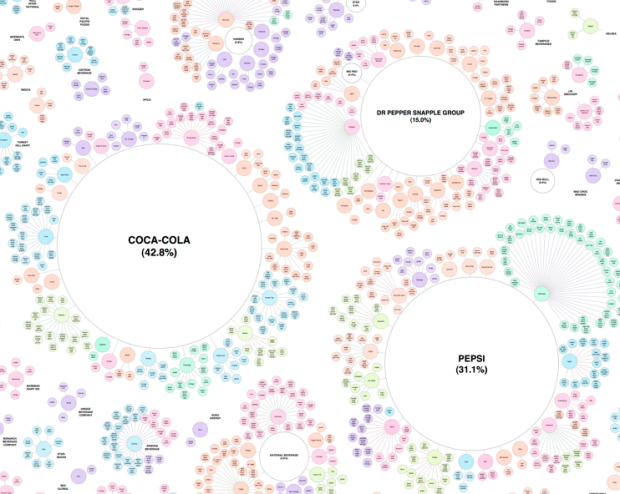When you buy soft drinks and other beverages at the grocery store, most likely you’re buying something that is part of a bigger brand. We know this. When you buy Powerade or Sprite, you’re buying from the Coca-Cola brand. When you buy Gatorade or Mountain Dew, you’re buying from Pepsi. Canada Dry and 7-Up come from the Dr. Pepper Snapple group. How far is this reach though?
Assistant Professor Philip Howard of Michigan State University maps the soft drink industry and its network of brands and beverages.
Three firms control 89% of US soft drink sales. This dominance is obscured from us by the appearance of numerous choices on retailer shelves. Steve Hannaford refers to this as “pseudovariety,” or the illusion of diversity, concealing a lack of real choice. To visualize the extent of pseudovariety in this industry we developed a cluster diagram to represent the number of soft drink brands and varieties found in the refrigerator cases of 94 Michigan retailers, along with their ownership connections.
Circles are sized by proportional annual sales of the eight largest companies and colored by type of drink. White circles represent the sales of each company. Main drinks branch off the base and then branch out further for variations of that drink. Bubbly. See the full-sized version to see it all.
The Dr. Pepper Snapple Group has a 15% market share with 20 brands and 109 varieties; Pepsi is in second at 31.1% with 18 brands 163 varities, and Coca-Cola, the granddaddy of them all, leads the way at 42.8% with 25 brands and 139 varieties.
What company does your soda come from?
[via | Thanks, Barry]



Pingback: @drpepper as a data visualization « Nimble Books LLC
Why should I care who owns the brand? There IS variety in that I can pick among various tastes and degrees of carbonation and so on…
In some markets, 3 companies are ideal, in others, maybe 800. Who knows which is which?
People worry about the weirdest things.
Variety from a consumer standpoint, but pseudo-variety from an economic/business standpoint. How does the oligopoly affect smaller companies and competition?
another significant point is that the (fizxy und sugary-) soft drinks industry dominates the (non alc) drinks industry – probably by controlling the distribution channels. getting a non-fizzy non-sugary drink in a normal cirner shop is harder than you’d expect. this is what the pseudo-variety refers to. this marketing fuelled obsession with sugary drinks is costing the health system dearly.
…and the figure doesn’t even begin to cover brands in foreign markets, like Georgia canned coffee in Japan, which is owned by Coke. Suntory and Kirin are the other big players in that market.
Nor does it show all the different types of Fanta that you can get in Japan (or at least one could get when I lived there in the 1990s).
I agree with Gabriel: As far as the beverages themselves are concerned, it is actual, not pseudo-, variety.
I’m pretty sure most people buy their beverages based on their appeal (whether actual, due to physical satisfaction, or artificial, due to marketing), not based on their manufacturer.
John Sculley, architect of the “Pepsi Generation” marketing strategy, would say you’re wrong.
http://www.cultofmac.com/john-sculley-on-steve-jobs-the-full-interview-transcript/63295
It’s all sweetened water. The only meaningful differences concern the identity of the sweetener, the amount of acidity, and the color. They’re all either bad for you, or indifferent. And they are all a waste of money.
Ultimately, *you* are the commodity.
most consumers purchase drinks (and food) based on taste and to a lesser extent ingredients, not by the manufacturing company. even so, if for some reason you wanted to “avoid” company A, there are two large companies that would welcome your business and a host of smaller ones, plus juices…
Do you know of a nice chart like this for beer instead of soft drinks?
Thanks!
I’m a co-op geek, and since cooperatives operate in just about every sector of the world economy, I tend to look for the examples in maps like this…and I buy based on manufacturer, as do many union members.
IYI: I found two cooperatives along the edges of the map: Sociedad Cooperativa Trabajador es de Pascual (Boing products, a unionized and worker-owned cooperative in Mexico) and Florida’s Natural Growers (farmer-owned). Technically Welch’s and Oceanspray have cooperatives integrated in their corporate structure, but this chart shows them as being subsidiaries to Dr. Pepper and Pepsi respectively. Perhaps there are bottling contracts in place that caused the researchers to make this connection, but I know Oceanspray is not a subsidiary of Pepsi…I’m less sure about the current situation at Welch’s other than their fruit is sourced from the National Grape Co-op.
Is there a way to zoom in on the pic so all the little bubbles are readable?
https://www.msu.edu/~howardp/softdrinkszoom.html